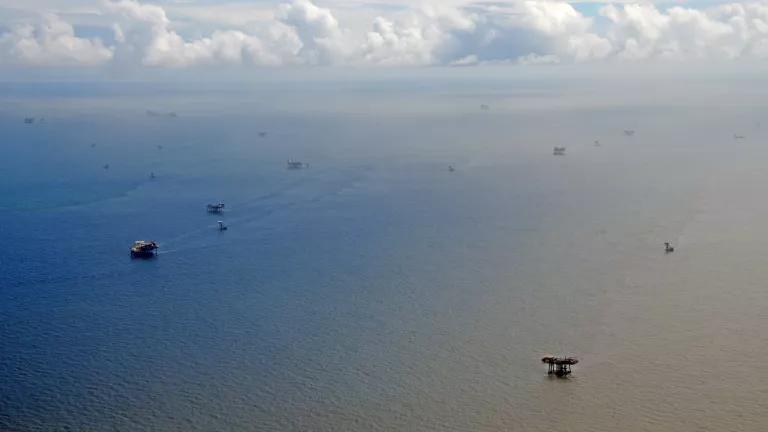New York Residents Say “No” to NESE Pipeline

Guest authored by New York Program Assistant Jhena Vigrass
Last Thursday, I spoke on behalf of NRDC at a public hearing on the proposed Northeast Supply Enhancement Project (NESE), a fracked gas pipeline that will run from Raritan Bay in New Jersey to a pipeline offshore of the Rockaways in Queens, New York. In my comments, I stated that the fracked gas pipeline’s draft environmental impact statement (DEIS), as drafted, does not satisfy the National Environmental Policy Act (NEPA). The hearing, held by the Federal Energy Regulatory Commission (FERC), took place in Bay Ridge, Brooklyn, and was one of four opportunities for the public to weigh in on the proposed fracked gas pipeline (other meetings were held in held in New Jersey and Pennsylvania).
NESE is an expansion of the already existing Transcontinental Gas Pipeline, a fracked gas pipeline that brings gas from the Gulf coast of Texas, Louisiana, Mississippi, and Alabama, through Georgia, South Carolina, North Carolina, Virginia, Maryland, and Pennsylvania to deliver gas to the New Jersey and New York City area.
In advance of the hearing, Surfrider, Sane Energy Project, 350 Brooklyn and other local groups hosted a press conference to highlight the public’s concerns over this project.
In an apparent attempt to make the public comment process less transparent and to isolate public commenters, instead of holding an open public hearing, FERC required members of the public to deliver their oral comments privately to a court reporter and a FERC representative. Representatives from the Department of Homeland Security were also present in the waiting room while commenters waited to speak to FERC.
Despite FERC’s attempts to limit public participation and coordination, we held our own public hearing, reading our comments aloud to each other in the waiting room. By the time I was finished giving my comments, there were almost 40 people present, and more arriving as people got off work.
I’ve included my comments below.
It is not too late to oppose the NESE! In order to move forward in New York and New Jersey, the pipeline must first obtain a Clean Water Act certification from each state. Last week, New York denied certification to NESE, but they will have an opportunity to resubmit their application. During that certification process, the public will have another opportunity to submit comments on the pipeline.
Follow NRDC New York on Facebook and Twitter to be notified when that happens.
We need your help!
Here are the comments I made to FERC last week:
“Good evening. My name is Jhena Vigrass and I am a staff member at the Natural Resources Defense Council, speaking on behalf of the 2.4 million NRDC members and activists worldwide.
“I’m also speaking as a native Brooklynite – who remembers summers swimming at Coney Island, biking under the Verrazano Bridge, birthdays on Rockaway Beach, and Staten Island sleepovers. Thank you for providing us the opportunity to speak today.
“The Northeast Supply Enhancement Project, as proposed, will cross through the Raritan, Sandy Hook, and Lower New York Bays. These bays support species of ecological, commercial, and recreational importance. The Raritan and Sandy Hook Bays are especially important areas for wildlife. Officially designated as a significant habitat complex by the US Fish and Wildlife Service, the area includes Essential Fish Habitat for 33 species. It also includes 23 species of birds and marine life that are federally listed endangered or threatened, and 18 that are state-listed endangered or threatened. Because of its unique location, Raritan Bay and Sandy Hook are especially significant as a migratory path for shorebirds, raptors, waterfowl, and landbirds. The Fish and Wildlife Service counts an average of over 60,000 birds every year.
“NRDC has reviewed the draft environmental impact statement for the Northeast Supply Enhancement Project, and has two primary objections.
“First, the Draft Environmental Impact Statement inadequately considers the cumulative downstream greenhouse gas emissions of the pipeline as required by the DC Circuit decision in Sierra Club v. FERC. FERC neither includes a measurement of the potential greenhouse gas emissions in this DEIS, nor does it explain specifically why a reasonable estimate could not be made. The mere absence of one single accepted standard to measure downstream greenhouse gases is not sufficient to excuse this omission.
“Second, the DEIS fails to sufficiently examine water quality impacts of the pipeline. As New York State recently observed, “Based on the Department’s initial review of the available information regarding the Raritan Bay Loop portion of the Project, the construction of the Project could have significant water quality impacts in New York State.” As proposed, this pipeline would cross 6 aquifers, one of which provides drinking water for approximately 3 million residents in New Jersey. The construction processes would increase turbidity of the water column and excavate portions of the seafloor, harming fish species’ ability to eat and breed.
“Pipelines put people’s health, safe drinking water, and our climate at risk. FERC’s 18-year-old policy for approving natural gas pipelines should be updated to include thorough consideration of greenhouse gas emissions, energy needs in the region where the pipeline would be built, and clean, non-pipeline alternatives. It’s time to stop building unnecessary fossil fuel infrastructure that pollutes our drinking water and ruins our environment. Thank you for your time.”




